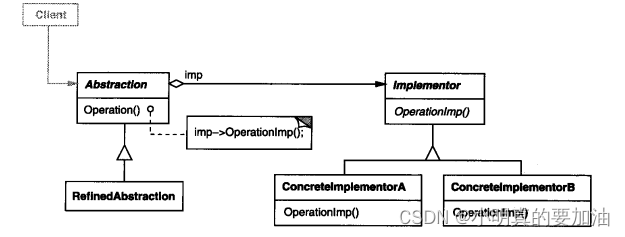一天一个设计模式---桥接模式
发布时间:2024年01月11日
概念
桥接器模式是一种结构型设计模式,旨在将抽象部分与实现部分分离,使它们可以独立变化而不相互影响。桥接器模式通过创建一个桥接接口,连接抽象和实现,从而使两者可以独立演化。
具体内容
桥接器模式通常包括以下几个要素:
- 抽象类(Abstraction): 定义抽象部分的接口,维护一个指向实现部分的引用。
- 扩充抽象类(Refined Abstraction): 对抽象类的扩展,可以引入更多的抽象行为。
- 实现接口(Implementor): 定义实现部分的接口,该接口不一定要与抽象接口完全一致,但必须能够被抽象接口调用。
- 具体实现类(Concrete Implementor): 实现实现接口,提供具体的实现。
类结构图

适用场景
- 分离抽象和实现: 允许抽象部分和实现部分独立变化,降低它们之间的耦合性。
- 可扩展性: 可以方便地添加新的抽象类和实现类,不影响现有的类结构。
- 隐藏细节: 客户端仅与抽象接口交互,不需要关心实现的细节,提高了系统的封装性。
实现
// 实现接口
class Implementor {
operationImpl() {
console.log("Implementor operation");
}
}
// 具体实现类A
class ConcreteImplementorA extends Implementor {
operationImpl() {
console.log("Concrete Implementor A operation");
}
}
// 具体实现类B
class ConcreteImplementorB extends Implementor {
operationImpl() {
console.log("Concrete Implementor B operation");
}
}
// 抽象类
class Abstraction {
constructor(implementor) {
this.implementor = implementor;
}
operation() {
console.log("Abstraction operation ->");
this.implementor.operationImpl();
}
}
// 扩充抽象类
class RefinedAbstraction extends Abstraction {
constructor(implementor) {
super(implementor);
}
operation() {
console.log("Refined Abstraction operation ->");
this.implementor.operationImpl();
}
}
// 客户端代码
const implementorA = new ConcreteImplementorA();
const implementorB = new ConcreteImplementorB();
const abstractionA = new RefinedAbstraction(implementorA);
const abstractionB = new RefinedAbstraction(implementorB);
abstractionA.operation(); // 输出:Refined Abstraction operation -> Concrete Implementor A operation
abstractionB.operation(); // 输出:Refined Abstraction operation -> Concrete Implementor B operation
文章来源:https://blog.csdn.net/weixin_44863521/article/details/135538258
本文来自互联网用户投稿,该文观点仅代表作者本人,不代表本站立场。本站仅提供信息存储空间服务,不拥有所有权,不承担相关法律责任。 如若内容造成侵权/违法违规/事实不符,请联系我的编程经验分享网邮箱:chenni525@qq.com进行投诉反馈,一经查实,立即删除!
本文来自互联网用户投稿,该文观点仅代表作者本人,不代表本站立场。本站仅提供信息存储空间服务,不拥有所有权,不承担相关法律责任。 如若内容造成侵权/违法违规/事实不符,请联系我的编程经验分享网邮箱:chenni525@qq.com进行投诉反馈,一经查实,立即删除!
最新文章
- Python教程
- 深入理解 MySQL 中的 HAVING 关键字和聚合函数
- Qt之QChar编码(1)
- MyBatis入门基础篇
- 用Python脚本实现FFmpeg批量转换
- 探索Steam搬砖项目:挖掘潜在收益的新机会
- Java中对于字节数组的操作(持续更新中....)
- 设计模式-建造者模式
- 2023年12月 C/C++(五级)真题解析#中国电子学会#全国青少年软件编程等级考试
- Echarts 绘制自定义热力图
- 水浒传之Screen的传奇-Linux/FreeBSD终端下的多窗口复用
- 机器人制作开源方案 | 并联索驱写字机器人
- 中国到雅加达 | 专业双清,轻松畅达印尼!
- 大甩卖-(CWRU)轴承故障诊数据集和代码全家桶
- 黑马点评04集群下的并发安全